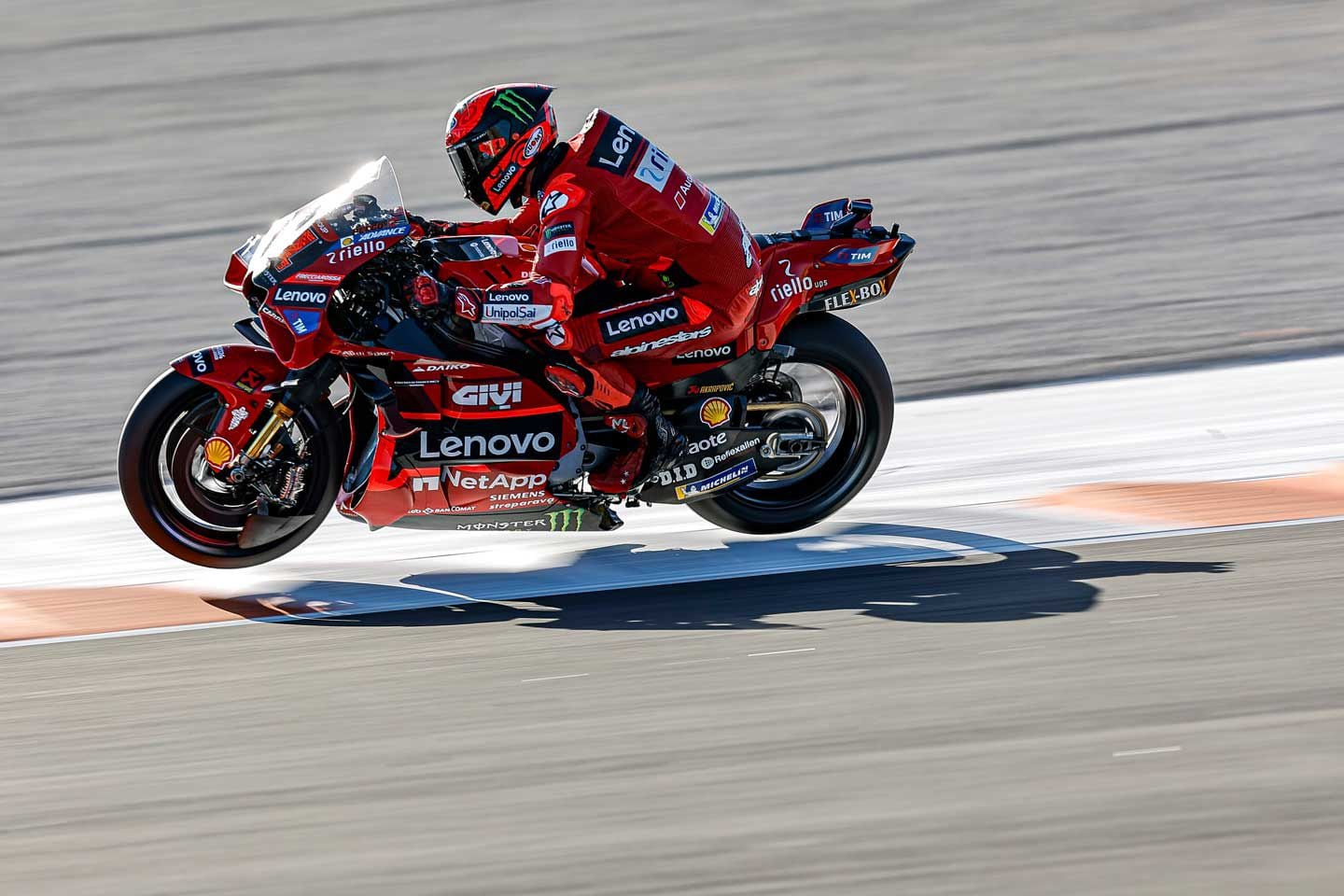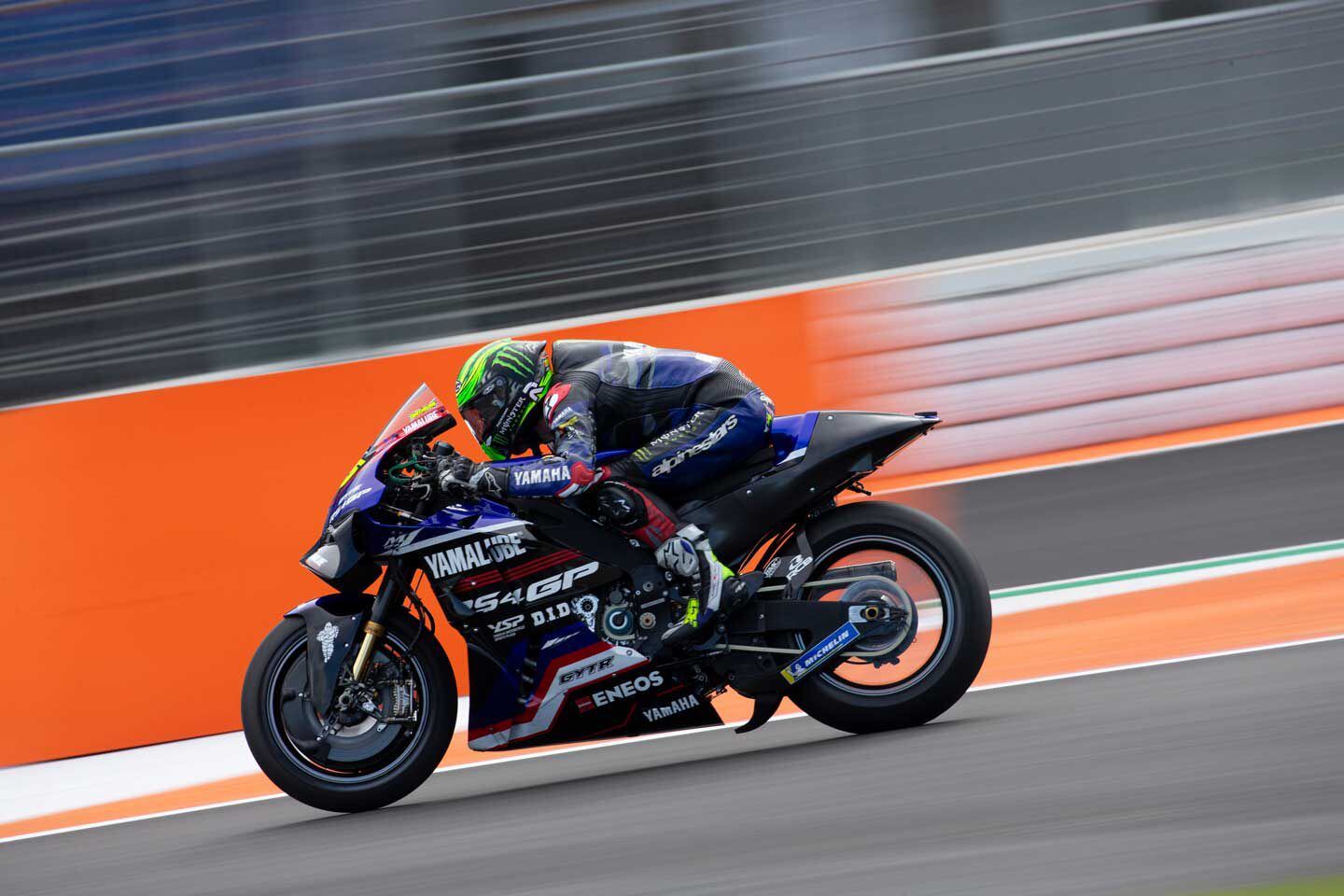
 |
|
|
#1 |
|
All the news that's fit to excerpt
Name: newsie
Location: who knows?
Join Date: Jun 2008 Motorcycle(s): only digital replicas Posts: Too much.
|
[cycleworld.com] - De-confusing Chassis Squat
What is the reason for lowering MotoGP racebikes with the push of a button? Why not just keep them squatting all the time?
Click here to view on their site.  Ask Kevin Cameron (Cycle World/)A reader has written, “One of the technical aspects of modern MotoGP I find most confusing is the use of so-called rear squat devices to accelerate out of corners. While watching a recent MotoGP practice session I heard Simon Crafar waxing poetic over the advantages of keeping the center of gravity lower with the rear squat device. It made me wonder how we got here. “When I learned to ride a bike it was explained to me that all motorcycles are made with a swingarm pivot explicitly designed to have anti-squat behavior on acceleration, as though squat were the enemy. But now MotoGP engineers seem to think squatting during acceleration is advantageous. What caused the thinking to change from squat = bad to squat = good? And if squat is good, do you really need a squat device, or could you just change the swingarm pivot to get rid of that pesky anti-squat behavior? Would squatting on acceleration ever be good for street bikes as well, or is there some reason this is only desired in racing?” Confusion regarding the role of squat can be resolved by seeing that two different circumstances are involved. Rear Squat Rear squat—and indeed any reduction in center of gravity height—during acceleration while upright allows the rider to accelerate a bit harder before hitting the “wheelie limit” set by front wheel lift.  Rear squat allows the rider to accelerate harder by lowering the CG. Wheel lift limit is increased as the rear squats. (Ducati/)Rear squat while accelerating, still leaned over in a corner takes weight off the front tire, reducing its ability to steer the motorcycle, and so causing it to run wide. This is corrected by setting the swingarm pivot at the correct height, allowing drive chain tension to generate a lift force that cancels acceleration squat. Motorcycle racing is naturally experimental and pragmatic: Whatever works to solve a specific problem will be adopted, provided it does not produce harmful side effects or cause itself to be banned because it works well. Dragsters are built low to raise their wheelie limit as high as possible. Back in 1973 one of our shop mechanics was trying to drag race his new Kawasaki 750 H2 Triple but couldn’t get anywhere because the front end kept popping up, forcing him to choose between wasting the run by chopping the throttle or letting the bike flick over backward. I suggested he try lowering the bike, which he did, by about 3 inches, front and rear. Next Sunday his launches were strong and his time slips were no longer embarrassing. But when Honda attempted to improve the corner exit acceleration of its 1988 NSR500 GP bike by lowering it and giving it a near-horizontal swingarm that actually encouraged squat, a nasty side effect appeared. During corner exit the accelerative transfer of weight off the front tire and onto the rear tire reduced the front tire’s ability to steer. The bike therefore ran wide, forcing the rider to throttle back, resulting in getting passed by those pesky Yamahas. Someone at Öhlins did an analysis of this and issued a four-page memo on how to use swingarm pivot location to prevent squat-and-push. Remember that this applies only to a motorcycle that is accelerating while still leaned over and turning. By the early 1990s the word on this had gotten around such that production bike models homologated for World Superbike were being manufactured with adjustable-height swingarm pivots to allow teams to legally give their riders bikes whose pitch attitude did not change when they applied throttle to accelerate while still leaned over. Squat-and-push could now be controlled or eliminated. The “Holeshot Device” Appears Motocross has been a prolific source of two-wheeled innovation. Suspension travel has increased in MX to the point at which bikes are so tall that wheelies seriously limit their starting-line acceleration. Someone decided to try compressing an MX bike’s front suspension by several inches, and holding it down with a kind of latch. The latch was equipped with a spring that would flip it out of engagement at the first sharp bump or brake application. This was given the name “holeshot device” because it could on a one-time basis raise the wheelie limit enough to win the drag race to turn 1. Naturally, this was tried in roadracing—still on a one-time-use basis. Being first into turn 1 is so important that soon, everyone’s bike had the holeshot device. As noted above, it works by reducing CG height, thereby making the bike more “dragster-like” (by making wheelies less easy). Lowering Both Ends of the Bike Soon one or more crew chiefs, riders, or engineers asked this question: If the front suspension holeshot device works during the straight-line acceleration from the start to the braking point for turn 1, what if we lowered and latched down the rear suspension as well? Naturally, because this further lowered the bike’s C of G, it further increased acceleration capability. The next step had a rule standing in its way: What if we built a device to lower the front and rear suspension every time the bike is accelerating or braking upright in a straight line? The rule forbids use of external electrical or hydraulic systems to power such ride height changes.  Ride height changes in MotoGP must be triggered by the rider, not automatically. (Andrea Wilson/)Upon approaching corners such a system could return to normal ride height to provide cornering clearance. Making Variable Ride Height Self-Powered To circumvent the rule, someone remembered the “Nivomat” constant ride height suspension units for touring bikes. Nivomat’s internal self-pumping action (driven by suspension movement) allowed it to maintain normal ride height despite the added weight of a passenger and/or luggage. Soon MotoGP bikes could be seen squatting at front and rear to increase straight-line acceleration or braking, then rising to normal height to provide cornering clearance when leaned over. It is currently forbidden by rule that such systems operate automatically, so the rider must trigger each ride-height change manually. A future ban of variable ride height is anticipated.
__________________________________________________
I'm a bot. I don't need no stinkin' signature... |
|
|

|
 |
 Similar Threads
Similar Threads
|
||||
| Thread | Thread Starter | Forum | Replies | Last Post |
| [cycleworld.com] - Aircraft, Race-Car, and Motorcycle Chassis | Ninjette Newsbot | Motorcycling News | 0 | August 17th, 2022 02:40 PM |
| Confusing electrical problem | tjthreat | 1986 - 2007 Ninja 250R Tech Talk | 8 | February 23rd, 2015 08:48 PM |
| Confusing engine | Drdoonta | 2008 - 2012 Ninja 250R Tech Talk | 13 | July 13th, 2012 05:34 PM |
| Confusing Oil level | solo440 | 2008 - 2012 Ninja 250R Tech Talk | 3 | December 9th, 2011 08:00 PM |
| [kropotkin thinks...] - Another Moto2 Chassis Switch: MZ To Swap To FTR Chassis For 2 | Ninjette Newsbot | Motorcycling News | 0 | February 26th, 2011 11:50 AM |
|
|